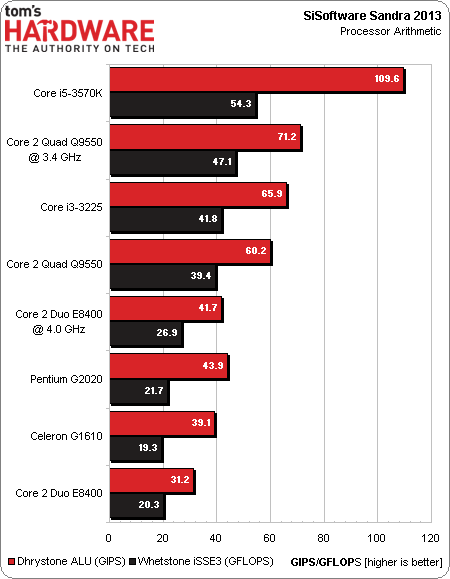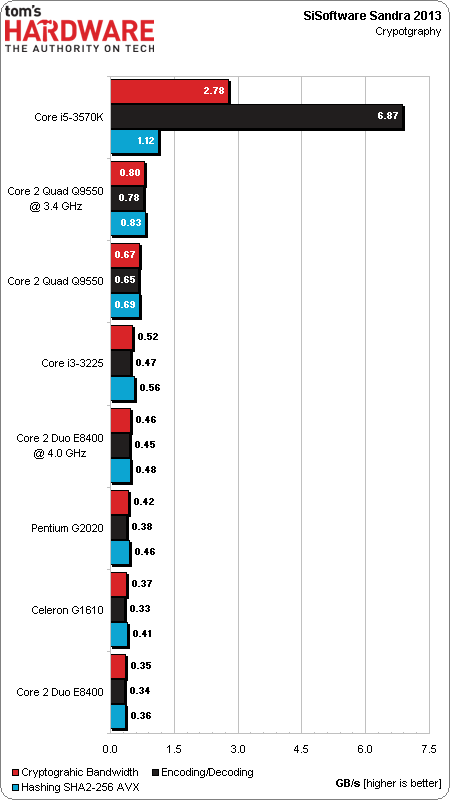Is This Even Fair? Budget Ivy Bridge Takes On Core 2 Duo And Quad
Reader requests affect much of the work we do, and we constantly receive email asking for this one: compare Intel's older Wolfdale- and Yorkfield-based designs against today's budget-friendly Ivy Bridge-based processors. Well, you asked, and we deliver.
Results: Synthetics
We're starting out with 3DMark 11, concentrating on the Physics (a processor-oriented metric) and Combined (which adds a graphics workload) tests. Because 3DMark employs one thread for each physical and logical core, the Core i3’s Hyper-Threading feature propels it far beyond the dual-core processors. Its higher clock rate also allows it hold off the stock Q9550. But once we remove that advantage through overclocking, the old Core 2 Quad jumps back into the lead.
As expected, our Core i5 control sits unchallenged at the top, benefiting from Ivy Bridge’s great per-clock performance, and Turbo Boost frequencies of 3.6 GHz for all four physical cores.
Sandra 2013 Arithmetic and Cryptography yield the same basic finishing order as 3DMark 11. So far, these synthetic tests give us an early indication of a few battles, just as we hoped. It appears, clock-for-clock, four physical Wolfdale cores have greater performance potential than Core i3’s dual-core/quad-thread design. Not all software is as well-threaded though, so we'll have to see how much Core i3 benefits from the newer platform and far greater memory bandwidth.
The dual-core battle is just as interesting. There’s no doubt that Ivy Bridge offers better per-clock performance. But is 4.0 GHz enough for Core 2 Duo E8400 to surpass the 2.9 GHz Pentium G2020? Meanwhile, there may be a heated battle at the bottom with the Celeron G1610 holding a slight lead over the stock E8400.
Sandra Arithmetic also touts the Core i5's great performance potential, while inclusion of AES-NI support distances the CPU even further in Cryptography.
Intel's Ivy Bridge architecture establishes an enormous advantage in memory bandwidth. Thankfully, the company enables official support for DDR3-1333 all the way down its product line, including Celerons based on the design. In contrast, Sandy Bridge-based 600-series Pentiums and Celerons are limited to DDR3-1066. Our pair of third-generation Core processors provides an additional bandwidth boost thanks to DDR3-1600 XMP memory settings.
Our LGA 775-based platform is limited to DDR2-1066, but we also saw very little additional bandwidth when we tried out a DDR3-capable board. Any performance advantage we observed showed up at more aggressive overclocks, not at the stock CPU or memory frequencies. Most owners of processors this old went the DDR2 route, since it was a lot more affordable than DDR3 back then.
Get Tom's Hardware's best news and in-depth reviews, straight to your inbox.
Current page: Results: Synthetics
Prev Page Test System Configuration And Benchmarks Next Page Results: Audio And Video-
ASHISH65 Wow! this is the review i am waiting from long time.Really good one for budget gamers.Reply -
DarkSable Now this is cool stuff.Reply
Also, amoralman, did you read this? It's basically assuring you that your C2D is still awesome as a budget processor. -
Steelwing Very nice review! I've got a C2D E6600 (2.4 GHz) and had been considering the Core i5-3570K (or possibly wait for a Haswell i5) and was wondering about the performance differences. My CPU is still good for a lot of apps, but I can definitely see a reason to upgrade.Reply -
AMD Radeon pentium dual core G2020 is the minimum i can recommend to budget gamers. i often listed it in sub 450 gaming PCReply -
lpedraja2002 Excellent article, I'm glad I have a more accurate idea on where I stand based on CPU performance, I'm still using my trusty Q6600, G0 @ 3.2ghz. Its good that Tom's still hasn't forgotten that a lot of enthusiast still are rocking Core 2 architecture lol. I think I can manage until Intel releases their next revolutionary CPU.Reply -
assasin32 I been wanting to see one of these for a long time but never thought I get to see it. I just wish they had the good ol e2160, and q6600 thrown into the mix. I have the e2180 OC to 3ghz. It's still chugging along surprisingly enough, I just realized how old the thing was last night after thinking about how long I've had this build and looking up when the main components were produced. Safe to say I got my use out of that $70 cpu, did a 50% OC to it :) and it still had room to go but I wanted to keep the voltage very low.Reply -
jrharbort I've always been curious about how well my own Core 2 Duo P8800 (45nm & 2.66GHz) would stand up against modern ivy bridge offerings. And even though I'm talking about he mobile space, I'm guessing the gains would be comparable to those seen by their desktop counterparts. Each day I'm reminded more and more that I seriously need to move on to a newer system, especially since I work with a lot of media production software. Thanks for the article, it provided some interesting and useful insight.Reply -
smeezekitty Kind of interesting that the old Core 2s beat the I5 in tombrader with TressFX on.Reply
Also holy crap on 1.45 vcore on the C2D -
Proximon I would not have predicted this. Not to this extent. I hope we can make these broader comparisons across years more frequently after this. I predict this will be a very popular article.Reply



